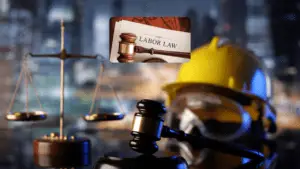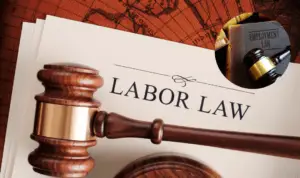Man toils for himself, his family, his country, and for God. Perhaps no other human activity has been the focus of so much academic and philosophical scrutiny than the very act that helps a man bring food to his table. It is no surprise, then, that this same act has helped build empires and toppled whole systems of thought.
Labor has been the foundation of modern economic systems. Since our departure from our primordial societies of hunting and gathering and catapulted into the industrial age, the value of human labor is undeniably high, so much so, that it is part of our human identity.
Labor serves as the fuel that makes the gears of economies running. Its indelible importance has urged nations to create laws that will shape it and sometimes, to a fault, limit its benefits.
Centuries of its evolution, labor laws have brought significant changes to workers’ rights and the elevation of labor standards and practices in national legislation. As Karl Marx has once put it, since labor is motion, time is its natural measure.
As it stands today, international and municipal laws have institutionalized protections to labor and workers’ rights. One of these rights is the right of the worker to strike.
As defined by Article 212(o) [now Article 219 (o), Renumbered Edition]1 of the Labor Code of the Philippines, a strike is “any temporary stoppage of work by the concerted action of employees as a result of an industrial or labor dispute”.
To strike, therefore, is a right under our system of laws. Our Constitution also recognizes this right but leaves to Congress the power to fix the manner on how this right should be enforced and exercised.
The Supreme Court in Bisig ng Manggagawa sa Concrete Aggregates vs. NLRC2 has said that:
“strike has been considered the most effective weapon of labor in protecting the rights of employees to improve the terms and conditions of their employment.”3
But just like any other right, it can also be prone to abuse. As a great equalizer, a strike that is used for unlawful means may swing the pendulum into illegality.
What is an example of an illegal strike?
An illegal strike is in broad terms any strike that is not in in conformity with the law. Anything that does not comply with the manner and procedure laid down by the law on how to strike is considered illegal.
In much more specific terms, the Supreme Court in Toyota Motors Phil. Corp. Workers Association vs. Toyota Motors Philippines Corp.4 has defined an illegal strike as possessing the following factors:
“(1) [when it] is contrary to a specific prohibition of law, such as strike by employees performing governmental functions; or5
“(2) [when it] violates a specific requirement of law[, such as Article 263 of the Labor Code on the requisites of a valid strike]; or6
“(3) [when it] is declared for an unlawful purpose, such as inducing the employer to commit an unfair labor practice against non-union employees; or7
“(4) [when it] employs unlawful means in the pursuit of its objective, such as a widespread terrorism of non-strikers [for example, prohibited acts under Art. 264(e) of the Labor Code]; or8
“(5) [when it] is declared in violation of an existing injunction[, such as injunction, prohibition, or order issued by the DOLE Secretary and the NLRC under Art. 263 of the Labor Code]; or9
“(6) [when it] is contrary to an existing agreement, such as a no-strike clause or conclusive arbitration clause.”10
An example of an illegal strike is one declared and staged contrary to Article 263 [now Article 278, Renumbered Edition]11 of the Labor Code. This provision of the Labor Code lays down the requirements of a valid strike:
- a notice of strike filed with the DOLE 30 days before the intended date of strike, or 15 days in case of unfair labor practice;
- strike vote approved by a majority of the total union membership in the bargaining unit concerned obtained by secret ballot in a meeting called for that purpose; and
- notice given to the DOLE of the results of the voting at least seven days before the intended strike. These requirements are mandatory and the failure of a union to comply with them renders the strike illegal.12
Respected Labor Law expert C.A. Azucena, Jr. noted that the evident intention of the law in requiring the strike notice and the strike-vote report is to reasonably regulate the right to strike, which is essential to the attainment of legitimate policy objectives embodied in the law.
The glaring point in the necessity of putting this requirements in the law is for labor to be truly protected. The interests of capital on one hand and workers’ rights on the other should be balanced.
What happens if you strike illegally?
There are several consequences of an illegal strike. While generally depending on the role in the union, an employee may be validly terminated if he has participated in an illegal strike. To amplify:
“Any worker whose employment has been terminated as a consequence of any unlawful lockout shall be entitled to reinstatement with full backwages. Any union officer who knowingly participates in an illegal strike and any worker or union officer who knowingly participates in the commission of illegal acts during a strike may be declared to have lost his employment status: Provided, That mere participation of a worker in a lawful strike shall not constitute sufficient ground for termination of his employment, even if a replacement had been hired by the employer during such lawful strike.”13
Employees may lose backwages and other financial assistance if dismissed from employment because of participation in an illegal strike.
Jurisprudence abound that a union leader who participates in an illegal strike is not entitled to separation pay because the act of engaging in an illegal strike constitutes serious misconduct.
On the part of the employer, the temporary stoppage of work may result to great financial losses which may affect the employees as well.
An illegal strike also strains the relationship between employer and employee. Instead of fixing the problem which brought the strike in the first place, may aggravate the situation. The risk of a police dispersal is also high especially when unlawful acts accompany the illegal strike.
Ultimately, an illegal strike puts a strain in the bargaining process. It has been told that the employer may make it even be harder to give in to the demands of the employees.
On the other hand, the employees will remain to be hard-pressed in demanding what they deem necessary, putting the negotiation process back to square one.
What is an illegal strike job action?
A job action refers to any organized protest by employees, which may refer to strikes, picketing, and other peaceful concerted activities.
Strictly speaking however, a job action is a unified activity by employees aimed at pressuring the employer to give in to their demands without resorting to a strike.
Therefore, job action is broader while strike is narrower. Some examples of a job action is holding pickets, wearing paraphernalia of support, refusal to render overtime, petition signing, and other analogous acts.
An illegal job action becomes illegal when the acts transcend the lawful means allowed by the law or the workplace. If the job action concerns harassment of other employees or non- union members, destruction of employers’ properties, harassment, and blocking of egress and ingress, it becomes unlawful.
Job actions are generally not aimed at stopping the work as compared to a strike. The employees usually employ job actions prior to striking, thus they employ generally lawful means.
What makes a job action illegal is when it becomes a violation of some other law or when it is clearly done to pressure the employer to commit unjust acts.
It may also occur when it is not done for valid causes. The term is not widely used in the Philippines but it can be seen in different employees’ collective actions.
The requirements in the law are already set in stone; thus, they are mandatory. There is no discretion left to union leaders and members to do away with the clearly-defined procedures. Failure to comply can lead to dire consequences; however, there are qualifications.
Can I be fired for striking?
A union member or an employee who participates in an illegal strike cannot be deemed to have abandoned his employment.
The employee’s participation can’t likewise be deemed as a ground to for termination of employment. This has already been settled by the Supreme Court in various decisions.
However, if during the course of the strike, the employee or union member has committed illegal acts, he can be validly terminated.
The union leader has a different fate. A union leader or officer who knowingly participated in the illegal strike can be terminated under Article 264 [now Article 279] of the Labor Code.
There is no more necessity to determine whether he participated in illegal acts. The rational of the law in this distinction is that a union officer is expected to lead the union in decision making.
The law places the onus on union leadership to steer the union to compliance with the law and ensure faithful conformity with the dictates of human dignity. Failure on this regard weighs heavily against the union leadership.
Can you refuse to join strike?
The right to strike is granted to any labor organization. This concomitant right comes from the right to join labor unions and organizations as granted by the Constitution.
The right to join includes the right not to join. In the same regard, the right to participate in a strike includes the right not to participate.
A union member or a non-union member may not be forced to strike without transgressing his constitutional and statutory rights. This is reflected in many legal principles but most profoundly manifest in the Labor Code itself.
Part of the procedural requirements for a valid strike is the approval of the majority vote of the members of the union to obtained by a secret ballot. Failure to get the threshold will render the strike.
The union cannot force the union member to vote in a certain way because to do otherwise will also result to declaring the strike illegal.
The very purpose of the strike vote in secret ballot is to ensure that the decision to strike rests with the majority sentiment of the union and not hijacked by the minority.
This also discourages wildcat strikes. The employees then to be empowered to demand for their rights from the employer should be genuinely represented by the sentiments of the many and not the few.
However, this does not authorize the union to force the minority to support a strike when they have made their stand clear in the votes.
Final Thoughts
The right to strike remains to be the most powerful bargaining chip of the employees. It has proven time and again that the power of collective workers’ actions may bring desired results in alleviating worker conditions.
Balanced bargaining for just pay, fair labor standards, and a better standard of living are the resulting benefits of the power of the employees to hold a strike. The law recognizes this and as such formally acknowledged it in the statute books and in the Constitution.
The right to strike with all its power may also be used to destroy. To craft the perfect balance, the laws have made sure to put safeguards by placing substantive and procedural requirements for a valid strike to occur.
These exacting standards were created to ensure that only legitimate and valid labor concerns are ventilated. Issues properly ventilated are better addressed. An unlawful strike will not bring the expected results but may instead be an avenue to worsening labor conditions.
Employer and employee relationships should not be antagonizing but rather cooperative and mutual. They are partners in economic development and to better each one’s lot.
They should also be open to amicably settling labor disputes immediately rather than waiting for the opportunity for a strike to happen.
A strike should always be a last resort and never be used to create unhealthy working conditions. The right to strike should be seen as a tool for improving employer-employee relationship.
- Labor Code of the Philippines, Renumbered, DOLE Edition[↩]
- G.R. No. 105090, September 16, 1993[↩]
- Ibid.[↩]
- G.R. No. 158798-99, October 19, 2007[↩]
- Ibid.[↩]
- Ibid.[↩]
- Ibid.[↩]
- Ibid.[↩]
- Ibid.[↩]
- Ibid.[↩]
- Labor Code of the Philippines, Renumbered, DOLE Edition[↩]
- Ibid.[↩]
- Article 264 [now Article 279 of Labor Code of the Philippines, Renumbered, DOLE Edition][↩]




